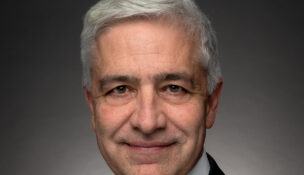In memoriam: Va. Gov. Linwood Holton
Kate Andrews //November 29, 2021//
The iconic fall 1970 photo of Virginia Gov. Linwood Holton escorting his daughter Tayloe to majority-Black John F. Kennedy High School is the enduring image of the Republican governor‘s term.
“He was fiercely independent,” says A.E. Dick Howard, the University of Virginia law professor who led the 1970 campaign to ratify a new state Constitution at Holton’s request. “He was never anybody else’s man. No one ever commanded Linwood Holton.”
A native of Big Stone Gap, Holton died at age 98 on Oct. 28, having served as the 61st governor of Virginia and the state’s first Republican governor since 1869. He ran for governor in 1965 and 1969 after having served in the U.S. Navy during World War II, graduating from Harvard Law School and working as an attorney in Roanoke. Married for 68 years to Virginia “Jinks” Rogers Holton, who survives him, Holton is also survived by his four children — Woody, Dwight and Tayloe Holton and former Virginia Secretary of Education Anne Holton, the wife of U.S. Sen. Tim Kaine — as well as 10 grandchildren.
Holton took power just as the segregationist Democratic Byrd Machine was beginning to lose its hold on Virginia politics after more than 40 years. In 1965, Holton was defeated by anti-desegregationist Democrat Mills E. Godwin Jr., but four years later, facing Democrat William Battle and three other candidates, Holton secured 52.5% of the vote, taking office in 1970.
Holton was considered a moderate Republican, but also, says Howard, “he was already to the left of the leadership of his own party,” represented nationally by President Richard M. Nixon. “He wasn’t able to command control of the Republican Party.”
Despite hailing from a remote corner of the state, Holton did not have much competition for the Republican nomination, because the party had a hold only on the the state’s Southwest region, which largely opposed the Byrd Organization. As governor, Holton voluntarily placed his children in desegregated, majority-Black Richmond city schools at a time when busing and desegregation were major national issues. He also created the Virginia Governor’s Schools program and increased the number of women and Black people employed by the state.
Because of Virginia’s gubernatorial one-term limit, Holton could not run for a consecutive term in 1973, and Godwin won a second nonconsecutive term. Holton served a year as assistant secretary of state for congressional relations in the Nixon administration and then became a shareholder at the McCandlish Holton law firm. In 1978, Holton finished third in a race for the Republican nomination for U.S. Senate, ultimately won by U.S. Sen. John Warner.
In later years as the GOP skewed increasingly conservative, Holton endorsed Democrats, including his son-in-law Kaine and future President Barack Obama.
Holton scored many legislative achievements as governor, including progress in higher education, environmental policies and transportation. However, he will likely be remembered for being a “central part of the transition from the Byrd Machine to genuine two-party politics,” Howard says, as well as being a “moral authority in politics, [in] the sense of doing the right thing regardless of consequences.”
t
















